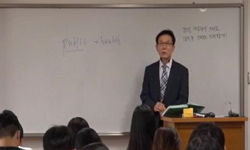This research has conducted studies on an Oriental medicine-based method of diagnosing of occupational musculoskeletal system diseases. This researcher has searched through existing relevant medical literature. Also, this researcher has worked on a mo...
http://chineseinput.net/에서 pinyin(병음)방식으로 중국어를 변환할 수 있습니다.
변환된 중국어를 복사하여 사용하시면 됩니다.
- 中文 을 입력하시려면 zhongwen을 입력하시고 space를누르시면됩니다.
- 北京 을 입력하시려면 beijing을 입력하시고 space를 누르시면 됩니다.

Moire 영상을 이용한 근골격계 질환의 한의학적 진단에 관한 연구 = A Study on Oriental Medical Diagnosis of Musculoskeletal Disorders using Moire Image
한글로보기https://www.riss.kr/link?id=A100884074
-
저자
이은경 ; 유승현 ; 이수경 ; 강성호 ; 한종민 ; 정명수 ; 천은주 ; 송용선 ; 이기남 ; Lee Eun-Kyoung ; Yu Seung-Hyun ; Lee Su-Kyung ; Kang Sung-Ho ; Han Jong-Min ; Chong Myong-Soo ; Chun Eun-Joo ; Song Yung-Sun ; Lee Ki-Nam
- 발행기관
- 학술지명
- 권호사항
-
발행연도
2000
-
작성언어
Korean
- 주제어
-
등재정보
KCI등재
-
자료형태
학술저널
-
수록면
72-92(21쪽)
- 제공처
-
0
상세조회 -
0
다운로드
부가정보
다국어 초록 (Multilingual Abstract)
This research has conducted studies on an Oriental medicine-based method of diagnosing of occupational musculoskeletal system diseases. This researcher has searched through existing relevant medical literature. Also, this researcher has worked on a moire topography using moire topography. In this course, this researcher has reached the following conclusion in relation to the possibility of using a moire topography as a diagnosing device of musculoskeletal system diseases under Oriental medicine . 1 The Western medicine outlines its criteria of screening occupational musculoskeletal system diseases as follows A. The occupational musculoskeletal diseases must clearly include one or more of the subjective symptoms characterized by pain, hypoesthesia dysaesthesia, anaesthesia. etc . B, There should be clinically admitted objective observations and diagnosis outlining that the disease concerned shows symptoms such as tenderness, induration. and edema that can appear with occupational musculoskeletal system diseases. dyscinesia should be admitted with the disease concerned, or there should be observations and diagnosis outlining that abnormality exists in electric muscular or nervous diagnosis and examination . C. It should be admitted that prior to the occurrence of symptoms or observations and diagnosis on musculoskeletal system-related diseases, a patient has been engaged in works with conditions requiring improper work posture or work movement. That is, this is an approach whereby they see abnormality in the musculoskeletal system come from material and structural defect, and adjust and control abnormality in the musculoskeletal system and secreta . 2. The Oriental medicines sees that a patient develops the pain of occupational musculoskeletal diseases as he cannot properly activate the flow of his life force and blood thus not only causing formation of lumps in the body and blocking the flow of life force and blood in some parts of the body. Hence, The Oriental medicine focuses on resolving the cause of weakening the flow of life force and blood, instead of taking material approach of correcting structural abnormality Furthermore , Oriental medicine sees that when muscle tension builds up, this presses blood vessels and nerves passing by, triggering circulation dyscrasia and neurological reaction and thus leading to lesion. Thus, instead of taking skeletal or neurophysiological approach. it seeks to fundamentally resolve the cause of the flow of the life force and blood in muscles not being activated. As a result Oriental medicine attributes the main cause of musculoskeletal system diseases to muscle tension and its build-up that stem from an individual's long formed chronicle habit and work environment. This approach considers not only the social structure aspect including companies owners and work environment that the existing methods have looked at, but also individual workers' responsibility and their environmental factors. Hence, this is a step forward method. 3 The diagnosis of musculoskeletal diseases under Oriental medicine is characterized by the fact that an Oriental medicine doctor uses not only photos taken by himself, but also various detection devices to gather information and pass comprehensive judgment on it. Thus, it is the core of diagnosis under Oriental medicine to develop diagnosing devices matching the characteristics of information to be induced and to interpret information so induced from the views of Oriental medicine. Diagnosis using diagnosing devices values the whole state of a patient and formal abnormality alike, and the whole balance and muscular state of a patient serves as the basis of diagnosis. Hence, this method, instead of depending on the information gathered from devices under Western medicine, requires devices that provide information on the whole state of a patient in addition to the local abnormality information that X-ray. CT, etc., can offer. This method sees muscle as the central par
동일학술지(권/호) 다른 논문
-
오적산(五積散)을 투여한 흰쥐의 뇌중 금속농도변화에 관한 연구
- 대한예방한의학회
- 민대기
- 2000
- KCI등재
-
여성의 피부건강행위에 대한 인식도와 실천도의 상관관계분석
- 대한예방한의학회
- 최은영
- 2000
- KCI등재
-
- 대한예방한의학회
- 최선미
- 2000
- KCI등재
-
- 대한예방한의학회
- 이용태
- 2000
- KCI등재




 ScienceON
ScienceON


